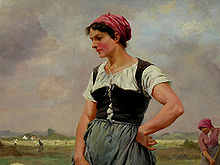Bodice
![]()
The title of this article is ambiguous. For other meanings, see bodice (disambiguation).
![]()
This article or subsequent section is not sufficiently supported by evidence (e.g., anecdotal evidence). Information without sufficient evidence may be removed in the near future. Please help Wikipedia by researching the information and adding good supporting evidence.
A bodice is a garment that tightly encloses the upper body and, depending on the context, refers to the top of a dress (waist), a stiffened dress top or a corset. It is still worn today in folk costumes, e.g. the dirndl and as a corsage. Its origin goes back to the Renaissance around the beginning of the 16th century. The bodice or corset shaped the silhouette of women in Europe until the early 20th century.
Bodices can be supporting undergarments over which (usually tight-fitting) blouses etc. are worn, but often a vest etc. is worn over a blouse, especially in traditional costumes. Usually the bust is pushed upwards to emphasize it, and the waist is cinched in to emphasize the difference between bust and waist.
With the replacement of the corset, the modern bodice emerged, which allow greater freedom of movement and still shape the body. In addition to the corselet, the bra and the girdle were created, as well as the panty girdle and the trouser corselet with the advent of pantyhose. Due to films and fashion designers taking up the idea, the corset has experienced a renaissance as party wear since the end of the 20th century.
In medical terms, the girdle is an elastic bandage that supports the lumbar spine and is used to support the treatment of back pain.
However, if the girdle is too tight, it can also be harmful to certain muscles.
A modern form of the bodice is shapewear.

Isarwinkel bodice robe

Woman with bodice in Joseph Julien - The Haymaking (19th century)
Search within the encyclopedia